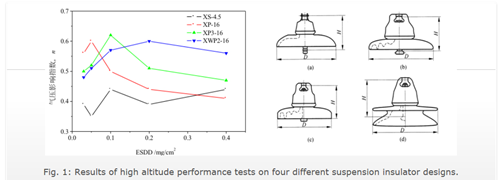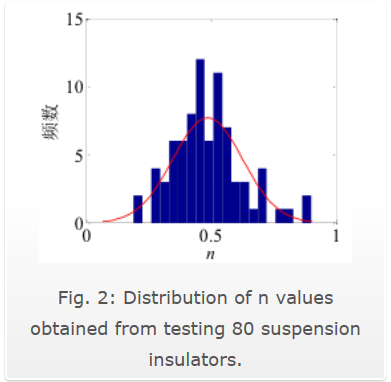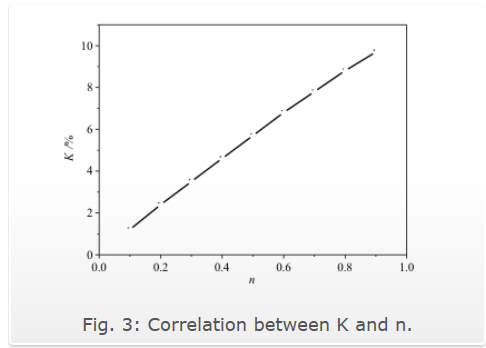Transmission lines the world over often have to traverse mountain ranges or plateaus situated at least 1000 m above sea level. In China, for example, it is estimated that some 60% of the country lies at this altitude or higher. In such cases, design of transmission and distribution systems has to take into account the fundamental changes in insulation performance that are associated with high altitude. This past INMR article, contributed by Professor Guan Zhicheng, recently retired from Tsinghua University’s Shenzhen Campus, discussed these changes as well as research on this topic conducted in China.
Areas with low air pressure and thin air impact the operation of electrical lines since voltage decreases with altitude – whether air gap discharge voltage, corona inception voltage or pollution flashover voltage. Moreover, the higher the altitude, the more problematic this will become in terms of the performance of line insulators, or indeed any high voltage insulation.
It is well known that, as altitude increases, changes in air pressure, temperature and humidity will all exert some influence on discharge voltage. However, it is the change in air pressure that is the most significant as well as the most consistent of these variables in terms of its effect.
When it comes to evaluating insulator performance, pollution flashover voltage is obtained when the humidity surrounding the test object reaches saturation. The influence of atmospheric humidity can therefore be ignored. Similarly, the regularity of temperature change as altitude increases is not always obvious. Pollution flashover testing is performed in a fog chamber where temperature is often different from ambient. Accounting for the influence of temperature on pollution flashover of insulators is relatively complex and remains a subject of debate. Indeed, no temperature correction factor is presently applied when it comes to insulator pollution flashover voltage.
Given the above, current research on how altitude impacts insulator performance tends to focus on the influence of air pressure – not humidity or temperature. The correlation between altitude and this parameter is shown in Table 1 below (obtained from actual measurements).
Table 1: Changes in Air Pressure & Relative Density with Altitude

Experts from a variety of countries, including Japan, Russia, and Canada have studied the influence of air pressure on insulator pollution flashover voltage and proposed that the correction for air pressure be expressed using an equation. In it, the parameter,
n, reflecting the value of the air pressure correction, is obtained by testing. Most agree with an
n value of 0.5 for a normal design of insulator and 0.6 for an anti-pollution design under AC voltage or 0.35 in the case of DC.
U(p)=U(p0)(p/P0)n
As early as the beginning of the 1980s, Tsinghua University and Chongqing University began research into insulator pollution flashover characteristics under high altitude conditions of low air pressure. Utilizing relatively small-scale tanks, pollution flashover tests were conducted to better understand and evaluate the influence of air pressure (altitude) on the pollution flashover characteristics of a variety of different types of insulators.
Recent UHV transmission projects in China have only accelerated research into how best to select external insulation at high altitude. Along with this has come rapid improvement in the facilities available for this purpose. For example, two large-scale air pressure tanks have been built and put into service in Beijing and in the central city of Wuhan. In the case of the Beijing facility, the tank body (consisting of a circular metallic structure of 20 m diameter and 25 m height) can simulate an altitude of up to 5500 m. Moreover, it is capable of performing not only icing and melting tests on insulators but also full-scale UHV pollution flashover tests under both AC and DC. The new facility in Wuhan, which has the same tank dimensions but is made of reinforced concrete, has also conducted numerous insulator pollution and icing flashover tests at simulated high altitudes.
China Southern Power Grid – one of the two major Chinese grid operators – set up a pollution laboratory in the southern city of Kunming at an altitude of 2100 m. The hall there measures 26 m x 28 m x 30 m and can carry out flashover testing at up to ± 1000 kV DC and 800 kV AC. In fact, Tsinghua University and the China Southern Power Grid’s Technical Centre have recently begun a joint research project at this facility to study the pollution flashover characteristics of ± 800 kV full-size suspension as well as station post insulators having different materials and profiles.
For its part, the State Grid Corp. of China built a test base in Yangbajing, Tibet, where the altitude is more than 4000 m. This facility includes a pollution laboratory and fog chamber of 9 m x 9 m x 11m and can do testing for ± 200 kV in DC and 200 kV in AC. The air pressure tanks in Beijing and Wuhan as well as the new high altitude test bases in Kunming and Tibet serve to complement one another. For example, the air pressure tanks artificially simulate high altitude and low air pressure to evaluate its influence on insulator pollution flashover behavior. Test results from the two high-altitude test sites can then verify these findings. At the same time, insulator pollution flashover experience under the high altitude conditions of the test bases can be directly applied during project design.
In China, universities, research institutes and power grid operators have all conducted tests on the tendency of insulator pollution flashover voltage to decrease as altitude increases. Pollution severity during the course of these tests has ranged from low to high, including both AC and DC flashover tests. A lot of test data has been obtained in the process and, while the actual figures may differ somewhat from one test to the next, basic tendencies have been the same. For example, all these tests have confirmed that the value of the exponent
n, (quantifying the influence of air pressure on pollution flashover voltage) depends not only on the voltage being applied, but also on type of insulator (whether porcelain, glass or composite), its shed profile and the severity of the pollution.
In this regard, tests were conducted by Tsinghua University on four different designs of suspension insulators, with findings for the resulting exponent
n values for the different profiles shown below. Designs of these insulators were classified as: (a) XS-4.5, (b) XP-16, (c) XP3-16 and (d) XWP2-16.
Test results showed that the
n value for the
type a insulator (with a relatively simple profile and no edges on the lower surface) is comparatively small. Moreover,
n values for this insulator vary quite a bit under different pollution severities. It was also found that the
n value of the anti-pollution
type d is not necessarily higher than for the common
type b and
type c insulators.

Chongqing University, China EPRI, China Southern Grid, and the Xi’an High Voltage Apparatus Research Institute all performed separate statistical analyses of the
n values obtained from these tests measuring influence of air pressure on pollution flashover voltage (and which included an AC pollution flashover test as well as a negative polarity DC pollution flashover test). There were a total of 80 test samples of AC suspension insulators, and the distribution of
n values obtained is shown in the histogram of Fig. 2. These
n values follow a normal distribution, with the average being 0.49.
A similar approach was then applied to AC post insulators and here the average
n value was 0.48 (i.e. very close to that for suspension insulators). The average
n value for DC suspension insulators, however, was 0.27, which is significantly lower than for AC.
The influence of altitude (air pressure) on pollution flashover voltage is usually expressed using the formula referred to earlier, which is basically an empirical formula to statistically process test data. The physical meaning of
n is not that clear. Tsinghua University has therefore proposed that the equation below be used instead.
U(p)=(1-Kh)U(p0)
The physical meaning of
K in this case is to show the percentage of pollution flashover voltage decrease for every increase of 1000 m in altitude, while
h expresses the relevant multiple of 1000 m. Comparing the two formulas, the following correlation between
K and
n can then be obtained:
K= {1-(p/p0)n}/h

Based on the data from Table 1, the correlation between K and n can be calculated as per this formula and is shown in Fig. 3.

For example, given the n value is 0.5, compared with flat areas (near sea level), the pollution flashover voltage of insulators at altitudes of 1000 m and 2000m will be reduced by 5.7% and 11.4% respectively. The diagram also assigns a more direct picture of the physical meaning of an n value.
Research at Tsinghua University has found that there are two basic reasons behind change of pollution flashover voltage as air pressure changes. One is that the volt-ampere characteristic of an electric arc changes with air pressure and second is the influence of the electric arc bridge flashover across the insulator’s profile, or sheds.
Research measuring the influence of shed profile on insulator pollution flashover characteristics at the high altitude test base in Tibet found that electric arc bridging the insulator profile has two distinct components: stable electric arc bridges and also electric arc breakdown in air. The first type – stable bridging electric arcs – are not easily extinguished and move due to external forces such as electromagnetism and thermal buoyancy. As the arc root moves, there is increased risk of a shortage of enough discharge distance, leading to flashover.
The second type is a ‘span bridge’. In this case, the passage of the arc is not the result of partial discharge but rather caused by breakdown of the air gap outside the insulator profile. This arc span bridge leads to a growing shortage of sufficient discharge distance and therefore a decrease in flashover voltage. Research found that the more shed profiles protruded and the shorter the distance between them, the higher the probability of the arc span bridge and the more significant the decrease in flashover voltage.
In high altitude areas, this ‘span bridge’ between insulator sheds is the type more likely to occur and therefore this imposes a more demanding requirement in terms of ideal insulator profile. In other words, those insulators that perform well near sea level are not necessarily equally suitable for service in mountainous areas.




